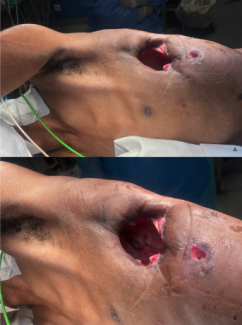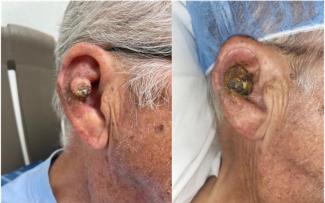Burn Size Estimation: A Critical Component of Burn Care
© 2023 HMP Global. All Rights Reserved.
Any views and opinions expressed are those of the author(s) and/or participants and do not necessarily reflect the views, policy, or position of ePlasty or HMP Global, their employees, and affiliates.
Questions
- What is the significance of estimating the size of a burn?
- What methods are used for estimating burn size?
- How accurate are methods used to estimate burn size?
- How has modern technology influenced the measurement of burn size?
Case Description
A 37-year-old male sustained deep flame burns to 48% of his body while attempting to convert a 50-gallon drum of oil into a trash can. Unfortunately, the drum was not empty, and he used an oxyacetylene torch to remove the lid (Figure 1A). The surface area of the burn was calculated by manipulating a 3-dimensional model on a mobile device (Figure 1B).1

Q1. What is the significance of estimating the size of a burn?
The total body surface area percentage (TBSA%) of a burn predicts mortality and correlates with the degree of hypermetabolism, dysregulated inflammatory response, multiorgan failure, an impaired immune system, sepsis, nutritional requirements, prolonged hospitalization, and the number of required surgical interventions.2 The American Burn Association also includes the assessment of burn size in their guidelines that determine the transfer of patients to a specialist burn center. The TBSA% burned is proportional to the degree of fluid extravasated from the vascular to the interstitial compartments, making it a unit of measurement in all resuscitation formulae. Although optimal outcomes require that fluid infusion is tailored to the patient’s physiological response, formulae provide a starting point. Inaccurate TBSA% estimation can therefore have serious consequences, with overestimation causing edema, pulmonary dysfunction, and abdominal compartment syndrome, while under-resuscitation can lead to burn shock, renal failure, and wound conversion.

Q2. What methods are used for estimating burn size?
In the early 19th century, Weidenfeld indicated a relationship between burn size and time of death, prompting him to measure burn size directly. He established a consistent ratio between distinct anatomical regions and total body surface area (TBSA), expressing them as proportions rather than percentages. Direct measurement of burn size was replaced by predictive formulae. Based on the formula of the Du Bois brothers written as Surface area (cm2) = weight (kg) 0.425 x height (cm) 0.725 x K (71.84),3 Berkow recalculated the surface area percentage of various body parts in relation to TBSA. Edith Boyd introduced a correction factor for children in 1935,4 which formed the basis for the chart created by Charles Lund and Newton Browder that is commonly used today (Figure 2).5 This chart, derived following the Coconut Grove Nightclub Fire in 1942, divided the body surface area into 12 regions. Notably, the neck, buttocks, and genitals were considered separately from the trunk. The hand was designated as 1%TBSA and different proportions were considered to account for human growth.


Two other widely used methods are the Rule of Nines and the Rule of Palms. The Rule of Nines, associated with a collaboration between Wallace in the United Kingdom and Tennison and Pulaski in the United States, divides the body into sections with each being a multiple of 9% of the TBSA (Figure 3). It was devised to enable a quick estimate in the pre-hospital situation and in the event of disasters and mass casualties.6 The Rule of Palms is another useful guide to estimate the size of irregular or scattered burns and approximates the size of the palm of one’s hand as 1% TBSA (Figure 4).7
Q3. How accurate are methods used to estimate burn size?
The current methods for estimating burn size have limitations. However, given that formulae are utilized only to initiate resuscitation, the significance of accuracy diminishes compared with the importance of precision and achieving consistency of outcomes by different assessors. Errors can occur during the transfer of the wound to the model, incorrect calculation, or due to flaws in the model itself. Inter-rater error causes the Lund and Browder chart to overestimate the size of small burns and underestimate large burns. The Rule of Nines is even less accurate as it apportions 5% to the anterior and posterior trunk that should be divided between the lower extremities and requires modification for children (Table 1). A Rule of Fives is proposed for patients weighing more than 80 kg (5% TBSA for each arm; 5 × 4 or 20% for each leg; 10 × 5 or 50% for the trunk; and 2% for the head) and a Rule of Eights for infants weighing below 10 kg (8% for each arm; 8 x 2 or 16% for each leg; 8 x 4 or 32% for the trunk; and 20% for the head).8 Modifications have been suggested for large-breasted women based on the size of the brassiere cup, though this has been criticized since cup volume relates to chest circumference rather than the surface area of the breast.9 The Rule of Palms also overestimates burn size, partly because of confusion as to what constitutes the palm. The metacarpus has been found to measure 0.5%TBSA in males and 0.4% in females, and with the fingers included measured 0.81% and 0.67% TBSA in males and females respectively.7 In children aged 1-13, the palm with fingers and without fingers accounts for 0.92% TBSA and 0.52%TBSA respectively.10

Q4. How has modern technology influenced the measurement of burn size?
The pursuit of burn size estimation through information technology (IT) systems began in the early 1980s. While these systems have reduced discrepancies among raters compared with manual calculations, their superiority in terms of accuracy remains unsupported.Initially, computer screens incorporated 2-dimensional (2D) Lund Browder charts, with TBSA% determined using pixel counts.11 Subsequently, Surface Area Graphic Evaluation II (SAGE II) was developed, accounting for age, height, and weight to yield more precise estimates.12 Hand-held 2D prototypes with push-button screens for the palm pilot environment soon followed.13 To achieve greater precision, Lee and colleagues introduced computer-aided three-dimensional %TBSA burn determination. This approach incorporated body areas that could not be represented on a 2D diagram, such as the lateral aspects of the body, the axillae, and the perineum (Figure 5). 3D Burn Vision was later introduced, with features enabling zoom and rotation and the electronic storage of burn depth and grafted areas.14

A recent Windows-based desktop program, BurnCase 3D, offers a graphical user interface that facilitates direct interaction with a virtual model of the patient’s body. The program offers models that are tailored to age, gender, height, and weight. Users can mark burned regions on a virtual model using standard input devices like a mouse, with the marked areas appearing in colors and patterns that can represent burn depth, surgical procedures, dressings, or medications. The software technology allows database support.14 Although most TBSA calculators and apps developed for smartphones and tablets are limited to 2D models, more recent developments have included 3D models.15 For example, BurnMed calculateds the burn surface area by manipulation of a 3D model on an iPhone and iPad through Apple’s iOS environment. However, while TBSA estimations using BurnMed showed lower variability compared to those derived from the Lund-Browder chart, they tended to underestimate burn size (Figure 1).1
Acknowledgments
Affiliation: Professor of Plastic and Reconstructive Surgery, Johns Hopkins University School of Medicine, Baltimore, MD (Ret)
Correspondence: Stephen M Milner, MBBS, BDS, DSc (Hon), FRCSE, FACS; stephenmilner123@gmail.com
Disclosures: The author discloses no relevant conflict of interest or financial disclosures for this manuscript.
References
1. Goldberg H, Klaff J, Spjut A, Milner S. A mobile app for measuring the surface area of a burn in three dimensions: comparison to the Lund and Browder assessment. J Burn Care and Res. 2014;35(6):480-483. doi:10.1097/BCR.0000000000000037
2. Kraft R, Herndon DN, Al-Mousawi AM, Williams FN, Finnerty CC, Jeschke MG. Burn size and survival probability in paediatric patients in modern burn care: a prospective observational cohort study. Lancet. 2012;379(9820):1013-1021. doi:10.1016/S0140-6736(11)61345-7
3. Du Bois D, Du Bois E. A formula to estimate the approximate surface area if height and weight be known. Arch Intern Med. 1916;17:863-871. doi:10.1001/archinte.1916.00080130010002
4. Boyd E. The Growth of the Surface Area of the Human Body. University of Minnesota Press; 1935.
5. Lund C, Browder N. The estimation of areas of burns. Surg Gynecol Obstet. 1944;79:352-358.
6. Knaysi GA, Crikelair GF, Cosman B. The rule of nines: its history and accuracy. Plast Reconstr Surg. 1968;41(6):560-563.
7. Rossiter ND, Chapman P, Haywood IA. How big is a hand? Burns. 1996;22(3):230-231. doi:10.1016/0305-4179(95)00118-2
8. Livingstone EH, Lee S. Percentage of burned body surface area determination in obese and nonobese patients. J Surg Res. 2000;91(2):106-110. doi:10.1006/jsre.2000.5909
9. Hidvegi N, Nduka C, Myers S, Dziewulski P. Estimation of breast burn size. Plast Reconstr Surg . 2004;113(6):1591-1597. doi:10.1097/01.prs.0000117189.75066.97.
10. Nagel TR, Schunk JE. Using the hand to estimate the surface area of a burn in children. Pediatr Emerg Care. 1997;13(4):254-255. doi:0.1097/00006565-199708000-00003.
11. Wachtel T, Brimm J, Knight M, Heisterkamp S, Frank H, Inancsi W. Research: computer-assisted estimate of the area and depth of burn. J Burn Care Rehabil. 1983;4(4):255-259. doi:0.1097/00004630-198307000-00003
12. Neuwalder JM, Sampson C, Breuing KH, Orgill DP. A review of computer-aided body surface area determination: SAGE II and EPRI's 3D Burn Vision. J Burn Care Rehabil. 2002;23(1):55-54. doi:10.1097/00004630-200201000-00011
13. Roth AC, Leon MA, Milner SM, Herting RL Jr, Hahn AW. A personal digital assistant for determination of fluid needs for burn patients. Biomed Sci Instrum. 1997;34:186-190.
14. Giretzlehner M, Ganitzer I, Haller H. Technical and medical aspects of burn size assessment and documentation. Medicina (Kaunas). 2021;57(3):242. doi:10.3390/medicina57030242
15. Wurzer P, Parvizi D, Lumenta DB, et al. Smartphone applications in burns. Burns. 2015;41(5):977-989. doi:10.1016/j.burns.2014.11.010















